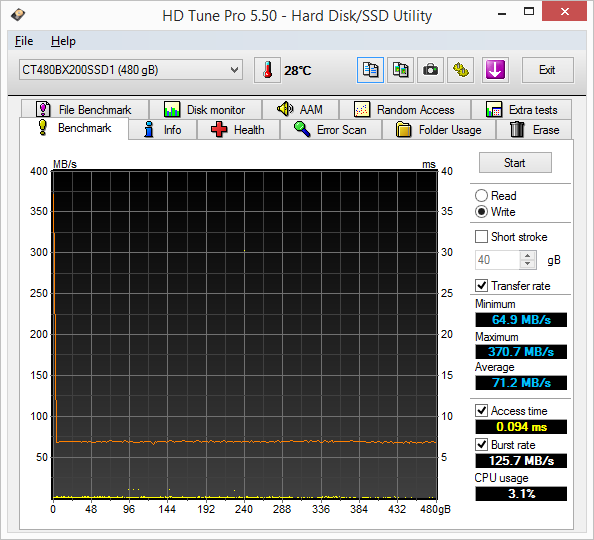Crucial BX200 SSD Review
Micron announced its 16nm TLC flash five months ago, and Crucial's BX200 is the first product to take advantage of the extra bit per cell. Is this late-comer competitive, or is it overwhelmed in a sea of superior solid-state storage?
Why you can trust Tom's Hardware
Four-Corner Testing
Before we get started with our standard suite, let's first look at the native sequential write speed of Micron's 16nm TLC memory. This test uses 64KB blocks across the entire LBA range. On the far left, we get a blip of the emulated SLC buffer's performance. That should give you an idea just how small the reserved area is on an empty drive. As soon as you move away from it, the TLC flash's performance is clarified.
The 480GB BX200's TLC NAND writes at just over 64 MB/s. The 960GB BX200 fares identically. This isn't steady state sequential write performance either; we're just working outside of the buffer.
To compare this with other TLC-based architectures, Samsung's 500GB 850 EVO facilitates 445 MB/s, SK Hynix's 16nm TLC hits 96 MB/s paired with the same SMI SM2256 controller and Toshiba A19 (also matched up with the SM2256) manages 81 MB/s. Our result with the Toshiba A19 was in a 240GB drive benefiting from less parallelism than the BX200s we're testing today, too. Sadly, Micron's native sequential write performance is less than what you get from many hard drives.
Sequential Read
Despite their triple-level-cell flash, today's SATA-attached SSDs manage incredible sequential read speeds that often get capped by their 6Gb/s bus. Crucial's 480GB BX200 isn't a stellar performer at a queue depth of one, though, falling well behind the best models in our chart of low-cost SSDs. The 960GB BX200 fares a bit better.
At high queue depths, all of the drives appear fairly similar. But most of us can't stress our SSDs that way; low queue depth results consequently become more valuable.
Sequential Write
Low sequential write performance and the bursty emulated SLC combine to cause some issues with our test, which incorporates light conditioning and a fair amount of data on the drive. We could smooth out the results with heavier conditioning that would force the drives into steady state. But that wouldn't represent the way most of use mainstream SSDs.
The waves are indicative of weak cache algorithms. There just isn't enough buffer available, and it can't flush fast enough to hide the native performance of Micron's TLC memory. The one drive that can is Samsung's 850 EVO with 3D V-NAND. Even enthusiasts would have a hard time running up against native TLC flash performance on that SSD.
Get Tom's Hardware's best news and in-depth reviews, straight to your inbox.
Crucial's 480GB BX200, the appropriate comparison against other 512GB-class repositories, struggles to keep pace with many of its competitors.
Random Read
The 480GB BX200 delivers the weakest random read performance at a queue depth of one. It scales well enough as the queue increases. However, such a low starting point gives us reason to worry. After all, random performance is what makes your computer feel fast, and it's closely related to latency.
Crucial should probably worry as well. Last week, Phison released an update to its partners capable of enabling 10,000 random read IOPS. We've waited nine months to get our hands on it. And there are several inexpensive Phison S10-based SSDs out there that could benefit.
Random Write
All of the TLC memory-based drives (except Samsung's 850 EVO) land along the lower random write performance line through the first chart, where we measure across queue depths. The 480GB BX200 is nearly isolated from even the low-performance drives until a queue depth of 16, where it doesn't really matter. You would have to go back to SATA 3Gb/s products to see a client drive from a major manufacturer with random write performance this meager at low queue depths.

Chris Ramseyer was a senior contributing editor for Tom's Hardware. He tested and reviewed consumer storage.
